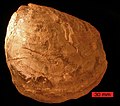List of index fossils
| Part of a series on |
| Paleontology |
|---|
 |
|
Paleontology Portal Category |
This article needs additional citations for verification. (March 2012) |

Index fossils (also known as guide fossils, indicator fossils or zone fossils) are fossils used to define and identify geologic periods (or faunal stages). They work on the premise that, although different sediments may look different depending on the conditions under which they were laid down, they may include the remains of the same species of fossil. If the species concerned were short-lived (in geological terms, lasting a few hundred thousand years), then it is certain that the sediments in question were deposited within that narrow time period. The shorter the lifespan of a species, the more precisely different sediments can be correlated, and so rapidly evolving types of fossils are particularly valuable. The best index fossils are common, easy-to-identify at species level, and have a broad distribution—otherwise the likelihood of finding and recognizing one in the two sediments is minor.[1]
Ammonites fit these demands well, and are the best-known fossils that have been widely used for this. Other important groups that provide index fossils are the corals, graptolites, brachiopods, trilobites, and echinoids (sea urchins). Conodonts may be identified by experts using light microscopy such that they can be used to index a given sample with good resolution. Fossilized teeth of mammals have also been used.
Geologists use both large fossils (called macrofossils) and microscopic fossils (called microfossils) for this process, known as biostratigraphy. Macrofossils have the advantage of being easy to see in the field, but they are rarer, and microfossils are very commonly used by oil prospectors and other industries interested in mineral resources when accurate knowledge of the age of the rocks being looked at is needed.
The series of deposits that spans the occurrence of a particular index fossil, is often referred to as that fossil's zone, enabling to relate different faunas through time. An example would be to say that Mesolenellus hyperborea occurs in the late Nevadella-zone.
How index fossils are used
"Imagine an E.L. Doctorow novel in which Alfred Tennyson, William Tweed, Abner Doubleday, Jim Bridger, and Martha Jane Canary sit down to a dinner prepared by Rutherford B. Hayes. ... a geologist could quickly decide -- as could anyone else -- that the dinner must have occurred in the middle 1870s, because Canary was 18 when the decade began, Tweed became extinct in 1878, and the biographies of the others do not argue with these limits." -- John McPhee, Basin and Range (1981).[2]
List of common index fossils [3]
References
- ^ Ghosh, v D. (2006). "Index fossils - Evidences from plant sources" (PDF). Resonance: 69–77. Retrieved 7 November 2013.
- ^ John McPhee, Basin and Range. 1981, Farrar, Straus & Giroux. ISBN 0-374-10914-1 . Reprinted in the omnibus Annals of the Former World, ISBN 0-374-10520-0
- ^ Index Fossils, from the US Geological Survey. Updated July 31, 1997.








